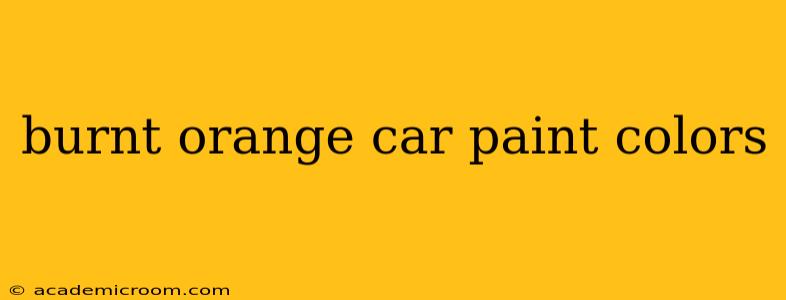Burnt orange car paint colors offer a unique blend of warmth, sophistication, and boldness. They evoke feelings of autumn sunsets, desert landscapes, and a touch of vintage flair. However, the term "burnt orange" encompasses a broad range of shades, each with its own personality and visual impact. This guide will explore the spectrum of burnt orange car paint, helping you choose the perfect hue for your vehicle.
What are the Different Shades of Burnt Orange Car Paint?
The beauty of burnt orange lies in its versatility. It's not a single, definitive color but rather a family of shades, influenced by the underlying base color and the addition of other pigments. Here are some key variations:
-
Classic Burnt Orange: This is the quintessential burnt orange – a deep, rich hue with a slightly muted tone. It's often described as a blend of orange and brown, with subtle reddish undertones. Think of the color of dried autumn leaves or a simmering sunset.
-
Russet Orange: Leaning more towards the brown side of the spectrum, russet orange is an earthy and sophisticated choice. It's a deeper, more subdued shade than classic burnt orange, offering a sense of understated elegance.
-
Copper Orange: This shade incorporates a metallic sheen, giving it a shimmering, luxurious appearance. Copper orange often includes hints of gold and bronze, adding depth and complexity to the overall look.
-
Terracotta Orange: This shade is warmer and more vibrant than other burnt oranges. It evokes the feeling of baked clay and often has reddish-brown undertones.
-
Pumpkin Orange: A brighter, more cheerful version of burnt orange, pumpkin orange is closer to a traditional orange but still retains a slightly muted, earthy quality.
What are Some Popular Burnt Orange Car Paint Names?
Car manufacturers often use unique names for their burnt orange hues. While specific names vary across brands and model years, some common naming conventions include:
-
Auburn: This classic name suggests a rich, reddish-brown orange.
-
Copper Canyon: Evokes the metallic gleam of copper and the rugged beauty of a desert canyon.
-
Desert Sunset: Paints a vivid picture of a vibrant, warm sunset.
-
Autumn Blaze: Captures the fiery intensity of autumn leaves.
-
Canyon Red: This shade might skew slightly more towards red but shares the warm earthy tones of burnt orange.
How Does Burnt Orange Car Paint Look on Different Car Types?
The impact of burnt orange can vary depending on the vehicle's style and size.
-
Sports Cars: Burnt orange can add a dramatic and aggressive edge to sports cars, creating a striking visual impact.
-
SUVs: On SUVs, burnt orange provides a sense of ruggedness and adventure.
-
Sedans: A burnt orange sedan can convey sophistication and a touch of individuality.
-
Classic Cars: Burnt orange is an excellent choice for classic cars, evoking a vintage and nostalgic aesthetic.
What are the Pros and Cons of Choosing Burnt Orange Car Paint?
Pros:
- Unique and Stylish: Burnt orange stands out from the crowd, making your car instantly recognizable.
- Versatile: It works well with various car styles and designs.
- Warm and Inviting: The hue projects warmth and sophistication.
Cons:
- Maintenance: Darker colors like burnt orange can show dirt and scratches more easily.
- Resale Value: While not a guaranteed negative, more unusual colors might slightly affect resale value depending on the market.
- Personal Preference: Ultimately, the suitability of any color depends on individual taste.
How Much Does Burnt Orange Car Paint Cost?
The cost of a burnt orange paint job varies depending on several factors, including the type of paint used (e.g., single-stage, metallic, pearl), the amount of preparation work required, the size of the vehicle, and the labor costs of the auto body shop. It's best to get quotes from several professionals to compare prices.
Is Burnt Orange a Good Color for a Car?
The "goodness" of burnt orange (or any car color) is entirely subjective. If you love the color and it suits your personality and vehicle style, then it's a great choice! The key is to carefully consider the shade, its impact on different vehicle types, and the potential maintenance involved before making your decision. Choosing a color you genuinely love will ultimately make your car a more enjoyable experience.
